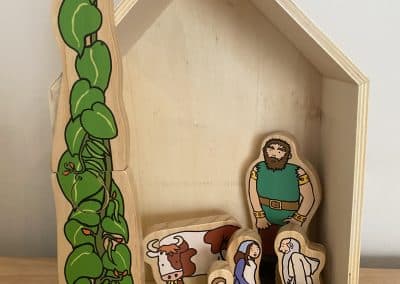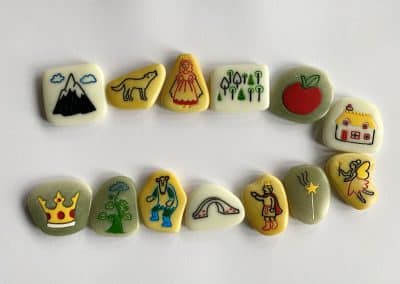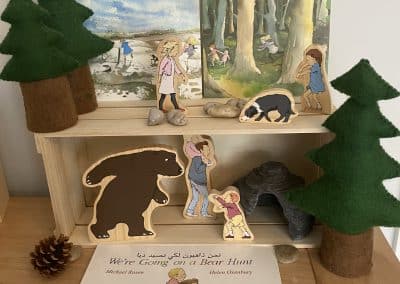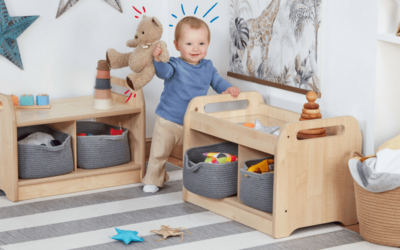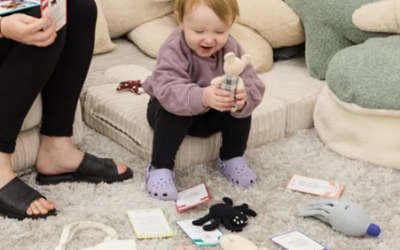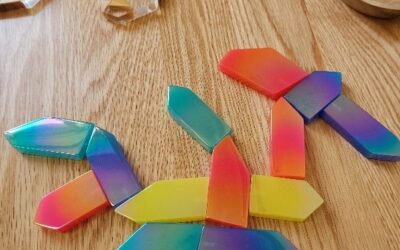Bringing Stories to Life in the Early Years
A child who reads will be an adult who thinks…
Daily reading with children is a gift that will have a lifelong impact on their learning. Hearing stories every day from a young age helps to close the word gap between children and introduces new vocabulary they may not hear in everyday conversations. Studies have shown that children who regularly hear the vocabulary in quality story books are better prepared for reading, and more likely to succeed when learning to read.
As educators, we can foster a love of reading and books in many ways such as bringing stories to life and providing open ended play opportunities.
Repetition of story language and rhyming words are crucial for the early development of language. For instance, story books such as ‘We’re Going on a Bear Hunt’ by Michael Rosen help children to make predictions and recite key phrases. Also, providing props to extend the play once familiar with the story allows children to make sense of the text and act it out. Small world resources such as characters, settings and masks provide a place for children to explore their newly acquired language in a natural and explorative way.
Children in my own class use props to retell the stories. But also merge familiar stories together and make up new stories.
Create and Inspire
Open ended story shelves where children can select their own materials and props to play will inspire them to create new stories. This is a very popular area in my reception class of 4 to 5 year olds. Allowing children to take ownership of their play and story making, rather than giving a preconceived idea of what small world play should look like. As a result, encouraging children to use their newly developed story language in a way they are comfortable with.
Traditional stories are perfect for sparking imagination, learning new vocabulary and exploring themes such as good versus evil. They help to understand the makeup of a story, from beginning to end.
Story stones provide opportunities for children to extend their language and guides them to make new stories. For example, with young children, they can choose to change some aspects of familiar stories such as the characters or setting (choosing new ones from the stones), creating a new story with the same structure. Such as, ‘Once upon a time, there were 3 little aliens…’ instead of 3 little pigs.
Leaving out writing implements is a great way to encourage children to write their own stories. I love the writing tool belts as they have encouraged some of the most reluctant writers in my class. Place them alongside your small world story shelves for the children to access easily.
My recommended traditional stories to use in the early years:
- The Three Little Pigs
- Little Red Riding Hood
- Jack and the Beanstalk
- Goldilocks and the Three Bears
- The Gingerbread Man
This blog was kindly written by our brand ambassador and EYFS teacher Katie Taylor. Find her on Instagram @earlyyearsoutdoor
Related blogs
Your Guide to the School-Based Nursery Capital Grant
What is the School-Based Nursery Capital Grant? For schools aiming to enhance their nursery facilities, the School-Based Nursery Capital Grant provides a simple funding solution. This grant is open to eligible state-funded primary schools in England that...
Top Tips for Play with Rhyme Time
Author: Alice Sharp Alice is nationally and internationally recognised as using a dynamic and innovative approach to children. She uses an experiential approach in her role as early childhood influencer, keynote speaker, mum and writer. She is waiting to uplift...
Top Tips for Play with Gems, Jewels and Sparkles!
Author: Alice Sharp Alice is nationally and internationally recognised as using a dynamic and innovative approach to children. She uses an experiential approach in her role as early childhood influencer, keynote speaker, mum and writer. She is waiting to uplift...
